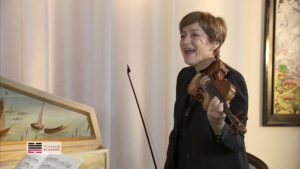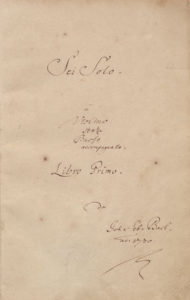BACH PARTITA NO. 1 IN B MINOR, BWV 1002, ALLEMANDE
CORNERSTONE LESSON BACH SOLO VIOLIN REPERTOIRE
In his Partitas, Bach treats the traditional dance form with great liberty, accentuating virtuosity, melodic inventions, rhythm and beautiful counterpoint elaborations. Master Teacher Miriam Fried considers all of these very demanding themes, together with technique, and exposes the importance of all these arguments in this outstanding masterclass.

Masterclass recorded in May 2016©iClassical Academy
"The Bass, in a solo violin piece, is your responsibility". With these words, Professor Fried explains how you cannot sacrifice the bass because of your focusing on the melody.
History of the piece
 Bach composed this Partita, together with all Partitas and Sonatas, in 1720, when he was the Kapellmeister at the court of Kothen, a town of the German region of Saxony. His intention was clearly to redesign the possibility of Violin, by writing compositions which demanded different voices and were able to lead both harmony and melody at the same time. To testify this, the title that he chose for the full book of 3 Sonatas and 3 Partitas was "Sei solo / à / Violino / senza /Basso/accompagnato". and many judged from the fair copy that he prepared that he had the intention to find a publisher.
Bach composed this Partita, together with all Partitas and Sonatas, in 1720, when he was the Kapellmeister at the court of Kothen, a town of the German region of Saxony. His intention was clearly to redesign the possibility of Violin, by writing compositions which demanded different voices and were able to lead both harmony and melody at the same time. To testify this, the title that he chose for the full book of 3 Sonatas and 3 Partitas was "Sei solo / à / Violino / senza /Basso/accompagnato". and many judged from the fair copy that he prepared that he had the intention to find a publisher.
Actually, this book, probably revised by his second wife, Anna Magdalena, didn't find any publisher during his life, perhaps because the so much innovative feature of the compositions didn't convince his contemporary publishers. But as we all know, nowadays the scores of these six compositions are amongst the most sold and published ones of all times.
Very often in the Bach solo pieces, we have to consider the context in which a phrase is played. Is it the end of something, or the beginning of something else?
What to expect in the Masterclass
All violinists know that the structure of the instrument doesn't allow to play more than two strings at a time. Nevertheless, Bach was able to secure the presence of many voices, and independent or continuous harmonic lines, through 3 or 4 note sequences in Arpeggio, or the system of Ostinato on the same string. This way Bach gives the possible broad musical message, and the listener completely forgets the material absence of polyphony and merges into the variety of different voices chasing each other. This fundamental characteristic is always in the basement of Miriam Fried's teaching, and every technique for bowing, fingering, and interpretation is continuously at the service of rendering the polyphony.
When you play Bach, you should never forget the little and big connections between phrases, which very often could make a big difference in your performance. Everything is connected to something else.
Watch the full Masterclass here
Not a member yet? Select your plan here
